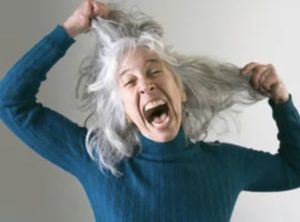Few hallmarks of old age are clearer than the sight of grey hair. As we grow older, black, brown, blonde or red strands lose their youthful hue. Although this may seem like a permanent change, new research reveals that the greying process can be undone—at least temporarily.
 Hints that grey hairs could spontaneously regain colour have existed as isolated case studies within the scientific literature for decades. In one 1972 paper, the dermatologist Stanley Comaish reported an encounter with a 38-year-old man who had what he described as a “most unusual feature.” Although the vast majority of the individual’s hairs were either all black or all white, three strands were light near the ends but dark near the roots. This signaled a reversal in the normal greying process, which begins at the root.
Hints that grey hairs could spontaneously regain colour have existed as isolated case studies within the scientific literature for decades. In one 1972 paper, the dermatologist Stanley Comaish reported an encounter with a 38-year-old man who had what he described as a “most unusual feature.” Although the vast majority of the individual’s hairs were either all black or all white, three strands were light near the ends but dark near the roots. This signaled a reversal in the normal greying process, which begins at the root.
In a study published in June in eLife, a group of researchers provide the most robust evidence of this phenomenon to date in hair from around a dozen people of various ages, ethnicities and sexes. It also aligns patterns of greying and reversal to periods of stress, which implies that this aging-related process is closely associated with our psychological well-being. These findings suggest that there is a window of opportunity during which greying is probably much more reversible than had been thought for a long time.
Around four years ago Martin Picard, a mitochondrial psychobiologist at Columbia University, was pondering the way our cells grow old in a multistep manner in which some of them begin to show signs of aging at much earlier time points than others. This patchwork process, he realised, was clearly visible on our head, where our hairs do not all turn grey at the same time. It seemed to him that our hair makes visible what we know happens at the cellular level. He wondered if there was something that could be learned from that…that maybe the hairs that turn white first were the more vulnerable or the least resilient.
 While discussing these ideas with his partner, Picard mentioned something in passing: if one could find a hair that was only partially grey—and then calculate how fast that hair was growing—it might be possible to pinpoint the period in which the hair began aging and thus ask the question of what happened in the individual’s life to trigger this change. He was thinking out loud…but unexpectedly, his wife turned to him and said she had seen such two-coloured hairs on her head. She went to the bathroom, plucked a couple of her own greying hairs—that’s when and how the project started!
While discussing these ideas with his partner, Picard mentioned something in passing: if one could find a hair that was only partially grey—and then calculate how fast that hair was growing—it might be possible to pinpoint the period in which the hair began aging and thus ask the question of what happened in the individual’s life to trigger this change. He was thinking out loud…but unexpectedly, his wife turned to him and said she had seen such two-coloured hairs on her head. She went to the bathroom, plucked a couple of her own greying hairs—that’s when and how the project started!
Picard and his team began searching for others with two-coloured hairs through local ads, on social media and by word of mouth. Eventually, they were able to find 14 people—men and women ranging from nine to 65 years old with various ethnic backgrounds (although the majority were white). Those individuals provided both single- and two-coloured hair strands from different parts of the body, including the scalp, face and pubic area.
The researchers then developed a technique to digitise and quantify the subtle changes in colour, which they dubbed hair pigmentation patterns, along each strand. These patterns revealed something surprising: In 10 of these participants, who were between age nine and 39, some greying hairs regained colour. The team also found that this occurred not just on the head but in other bodily regions as well. This happens thus not just in one person or on the head but across the whole body. The reversibility only appeared in some hair follicles, so it’s likely that it’s limited to specific periods when changes are still able to occur.
Most people start noticing their first grey hairs in their 30s—although some may find them in their late 20s. This period, when greying has just begun, is probably when the process is most reversible. In those with a full head of grey hair, most of the strands have presumably reached a “point of no return,” but the possibility remains that some hair follicles may still be malleable to change.
What was most remarkable was the fact that they were able to show convincingly that, at the individual hair level, greying is actually reversible. What scientists are learning is that, not just in hair but in a variety of tissues, the biological changes that happen with age are, in many cases, reversible—this is a nice example of that.
 The team also investigated the association between hair greying and psychological stress because prior research hinted that such factors may accelerate the hair’s aging process. Anecdotes of such a connection are also visible throughout history: according to legend, the hair of Marie Antoinette, the 18th-century queen of France, turned white overnight just before her execution at the guillotine.
The team also investigated the association between hair greying and psychological stress because prior research hinted that such factors may accelerate the hair’s aging process. Anecdotes of such a connection are also visible throughout history: according to legend, the hair of Marie Antoinette, the 18th-century queen of France, turned white overnight just before her execution at the guillotine.
In a small subset of participants, the researchers pinpointed segments in single hairs where colour changes occurred in the pigmentation patterns. Then they calculated the times when the change happened using the known average growth rate of human hair: approximately one centimeter per month. These participants also provided a history of the most stressful events they had experienced over the course of a year.
This analysis revealed that the times when greying or reversal occurred corresponded to periods of significant stress or relaxation. In one individual, a 35-year-old man with auburn hair, five strands of hair underwent greying reversal during the same time span, which coincided with a two-week vacation. Another subject, a 30-year-old woman with black hair, had one strand that contained a white segment that corresponded to two months during which she underwent marital separation and relocation—her highest-stress period in the year.
 For now, the next step is to look more carefully at the link between stress and greying. Picard and colleagues are currently putting together a grant to conduct another study that would examine changes in hair and stress levels prospectively—which means tracking participants over a specified period of time rather than asking them to recall life events from the past.
For now, the next step is to look more carefully at the link between stress and greying. Picard and colleagues are currently putting together a grant to conduct another study that would examine changes in hair and stress levels prospectively—which means tracking participants over a specified period of time rather than asking them to recall life events from the past.
Eventually, Picard says, one could envision hair as a powerful tool to assess the effects of earlier life events on aging—because, much like the rings of a tree, hair provides a kind of physical record of elapsed events. Hair would seem to encode part of our biological history: it grows out of the body, and then it crystallises into a‘hard’, stable structure that holds the memory of our past.
Interesting, right?
REFERENCES:
Stanley Comaish. White Scalp Hairs Turning Black – An Unusual Reversal of the Ageing Process. British Journal of Dermatology, May 1972, Volume 86, Issue 5, Pages 513-514.
Ayelet M. Rosenberg et al. Quantitative mapping of human hair greying and reversal in relation to life stress. eLife2021, 10:e67437
Zhang et al. Hyperactivation of sympathetic nerves drives depletion of melanocyte stem cells. Nature 2020, volume 577, pages 676–681.
Eva M. J. Peters et al. Hair and stress: A pilot study of hair and cytokine balance alteration in healthy young women under major exam stress. PLoS ONE 12(4): e0175904.
Alexander A. Navarini and Stephan Nobbe. Marie Antoinette Syndrome. Archives Dermatology 2009, Volume 145(6), page 656.
